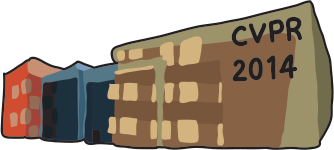-
Unsupervised Trajectory Modelling using Temporal Information via Minimal Paths
AbstractThis paper presents a novel methodology for modelling pedestrian trajectories over a scene, based in the hypothesis that, when people try to reach a destination, they use the path that takes less time, taking into account environmental information like the type of terrain or what other people did before. Thus, a minimal path approach can be used to model human trajectory behaviour. We develop a modified Fast Marching Method that allows us to include both velocity and orientation in the Front Propagation Approach, without increasing its computational complexity. Combining all the information, we create a time surface that shows the time a target need to reach any given position in the scene. We also create different metrics in order to compare the time surface against the real behaviour. Experimental results over a public dataset prove the initial hypothesis' correctness.
Related Material
[pdf][bibtex]@InProceedings{Cancela_2014_CVPR,
author = {Cancela, Brais and Iglesias, Alberto and Ortega, Marcos and Penedo, Manuel G.},
title = {Unsupervised Trajectory Modelling using Temporal Information via Minimal Paths},
booktitle = {Proceedings of the IEEE Conference on Computer Vision and Pattern Recognition (CVPR)},
month = {June},
year = {2014}
}
CVPR 2014 open access
These CVPR 2014 papers are the Open Access versions, provided by the Computer Vision Foundation.
Except for the watermark, they are identical to the accepted versions; the final published version of the proceedings is available on IEEE Xplore.
Except for the watermark, they are identical to the accepted versions; the final published version of the proceedings is available on IEEE Xplore.
This material is presented to ensure timely dissemination of scholarly and technical work.
Copyright and all rights therein are retained by authors or by other copyright holders.
All persons copying this information are expected to adhere to the terms and constraints invoked by each author's copyright.

